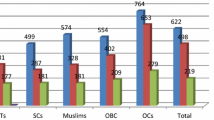Abstract
Exploitation of vulnerable groups such as refugees for cheap labour is a notorious phenomenon in Turkey. Up to 2017, only 1.3% of around 3 million Syrian refugees registered in Turkey have been granted a work permit, leaving the overwhelming majority dependent on undeclared employment with all its negative implications: high-risk jobs, pay below minimum wage and lack of access to social security. Mobile phone metadata allows for a detailed view on commuting routines and migration, possibly unearthing employment situations which are not captured otherwise. This study proposes a methodological framework for detecting fine-granular socio-economic occurrences in situations where little training data are available. As a proof of concept, the study applies the methodology to identify potentially undeclared employment among refugees in Turkey by analyzing seasonal migration and commuting patterns in two specific cases: during the late-summer hazelnut harvest in the province of Ordu and at the construction site of the Istanbul Airport. The study finds clear indication for work-related migration and commuting patterns among refugees hinting at undeclared employment. The proposed framework therefore provides an analytical instrument to make targeted interventions such as controls more effective by detecting small areas where undeclared work likely takes place.
Access this chapter
Tax calculation will be finalised at checkout
Purchases are for personal use only
Similar content being viewed by others
Notes
- 1.
Retrieved August 15, 2018: https://data.humdata.org/dataset/turkey-administrative-boundaries-levels-0-1-2.
- 2.
Note: The figure shows the weekly total number of calls averaged over all antennas in the control and treatment group. The trends for other network activity measures, like number of SMS, call volume or total number of interactions, i.e. SMS and calls, look similar.
- 3.
Note: The figure shows the annual total number of calls in a certain hour averaged over all antennas in the control and treatment group. The trends for other network activity measures, like number of SMS, call volume, or total number of contacts, i.e. SMS and calls, look similar.
References
Almaatouq A, Prieto-Castrillo F, Pentland A (2016) Mobile communication signatures of unemployment. In: International conference on social informatics. Springer, Cham, pp 407–418
De Nadai M, Staiano J, Larcher R, Sebe N, Quercia D, Lepri B (2016) The death and life of great Italian cities: a mobile phone data perspective. In: Proceedings of the 25th international conference on world wide web, International World Wide Web conferences steering committee, pp 413–423
Dong L, Chen S, Cheng Y, Wu Z, Li C, Wu H (2017) Measuring economic activity in china with mobile big data. EPJ Data Sci 6(1):29
Pokhriyal N, Jacques DC (2017) Combining disparate data sources for improved poverty prediction and mapping. Proc Nat Acad Sci 114(46):E9783–E9792
Salah AA, Pentland A, Lepri B, Letouzé E, Vinck P, de Montjoye YA, Dong X, Dağdelen Ö (2019) Data for refugees: the D4R challenge on mobility of Syrian refugees in Turkey. In: Data for refugees challenge workshop
Schmid T, Bruckschen F, Salvati N, Zbiranski T (2017) Constructing sociodemographic indicators for national statistical institutes by using mobile phone data: estimating literacy rates in Senegal. J R Stat Soc Ser A (Stat Soc) 180(4):1163–1190
Sundsøy P, Bjelland J, Reme BA, Jahani E, Wetter E, Bengtsson L (2017) Towards real-time prediction of unemployment and profession. In: International conference on social informatics. Springer, Cham, pp 14–23
Toole JL, Lin YR, Muehlegger E, Shoag D, González MC, Lazer D (2015) Tracking employment shocks using mobile phone data. J R Soc Interface 12(107):20150185
Undisclosed (2016) Integration of Syrian refugees under temporary protection into the Turkish labor market: challenges and opportunities. Roundtable—summary and outcomes report. Technical report, Fair Labor Association
Xu Y, Belyi A, Bojic I, Ratti C (2018) Human mobility and socioeconomic status: analysis of Singapore and Boston. Computers, Environment and Urban Systems
Author information
Authors and Affiliations
Corresponding author
Editor information
Editors and Affiliations
Rights and permissions
Copyright information
© 2019 Springer Nature Switzerland AG
About this chapter
Cite this chapter
Bruckschen, F., Koebe, T., Ludolph, M., Marino, M.F., Schmid, T. (2019). Refugees in Undeclared Employment—A Case Study in Turkey. In: Salah, A., Pentland, A., Lepri, B., Letouzé, E. (eds) Guide to Mobile Data Analytics in Refugee Scenarios. Springer, Cham. https://doi.org/10.1007/978-3-030-12554-7_17
Download citation
DOI: https://doi.org/10.1007/978-3-030-12554-7_17
Published:
Publisher Name: Springer, Cham
Print ISBN: 978-3-030-12553-0
Online ISBN: 978-3-030-12554-7
eBook Packages: Computer ScienceComputer Science (R0)




